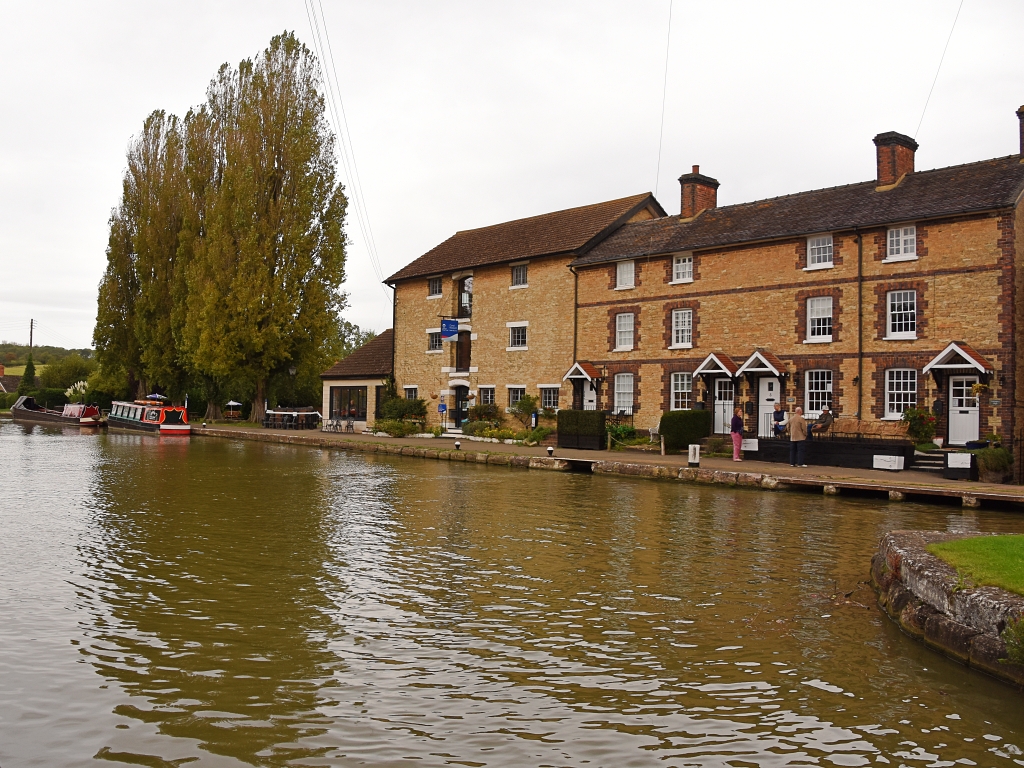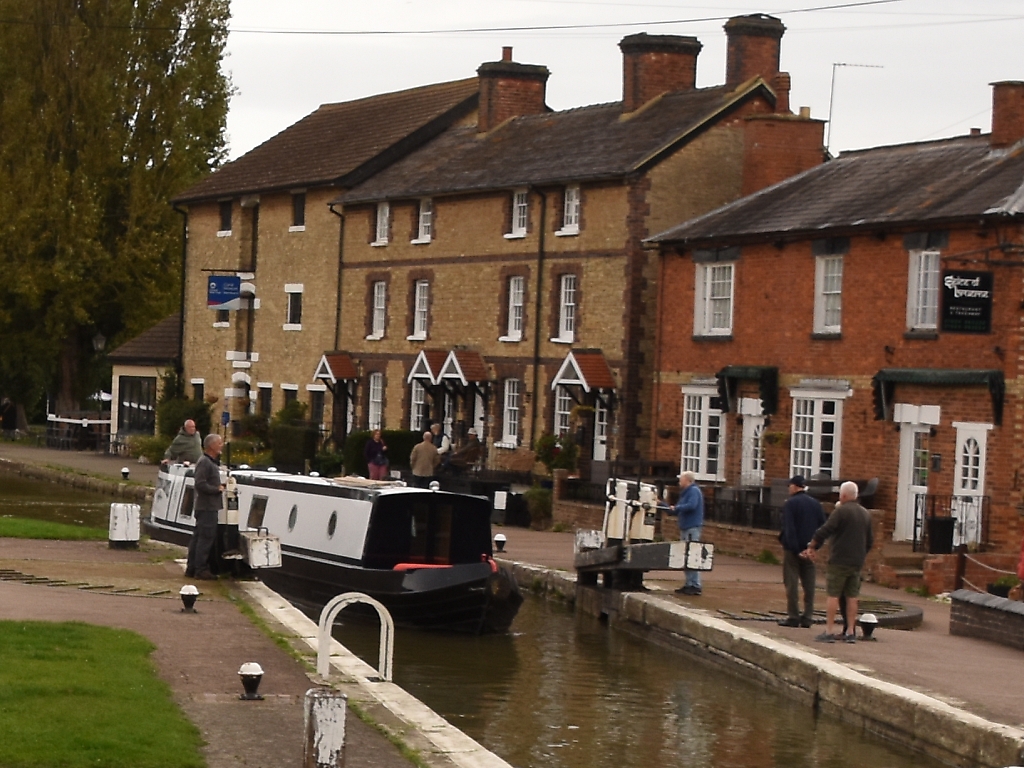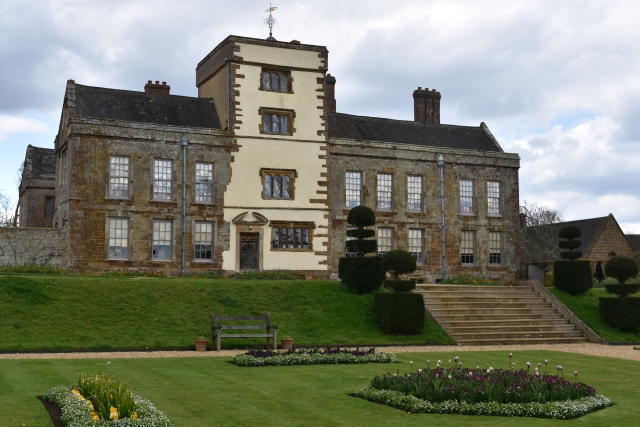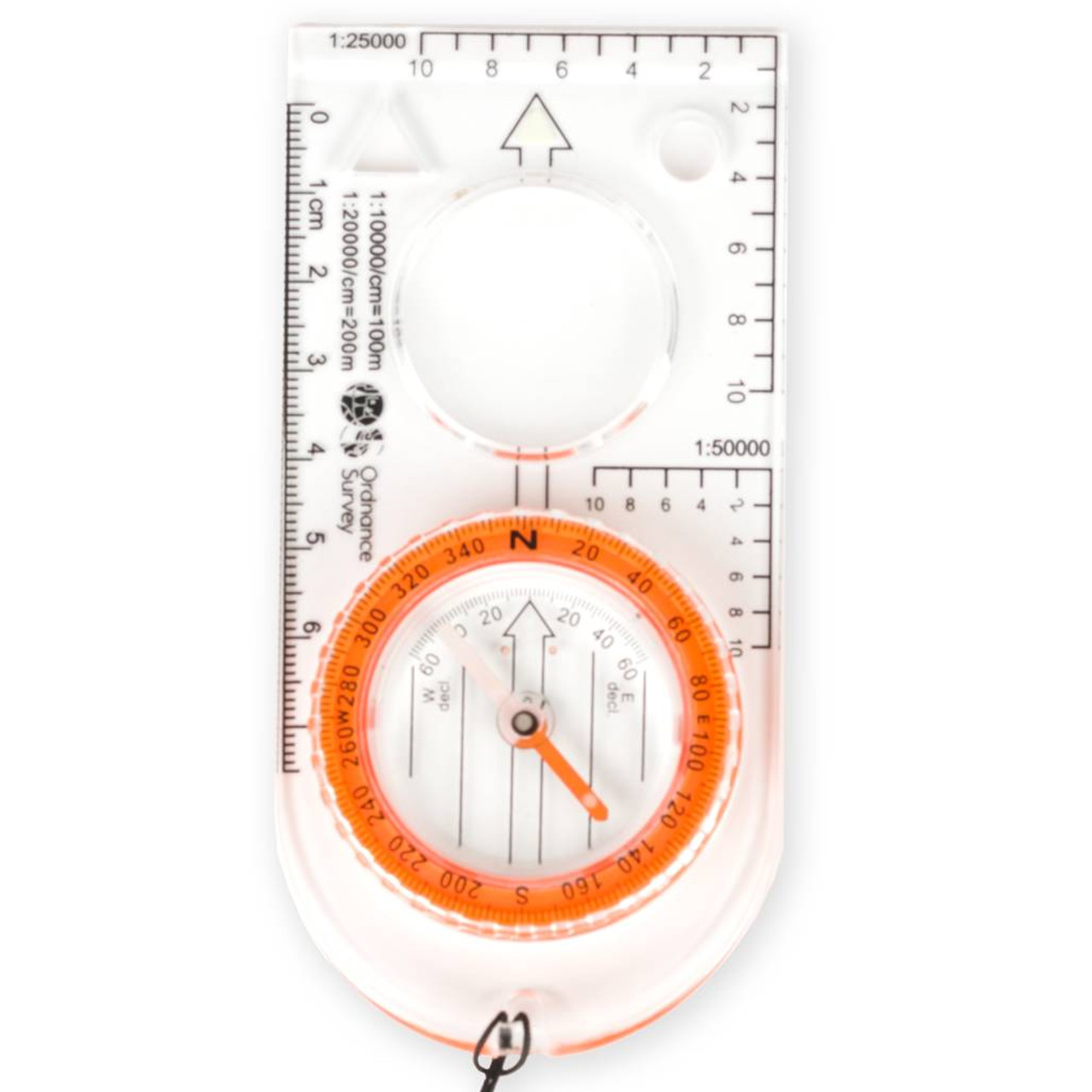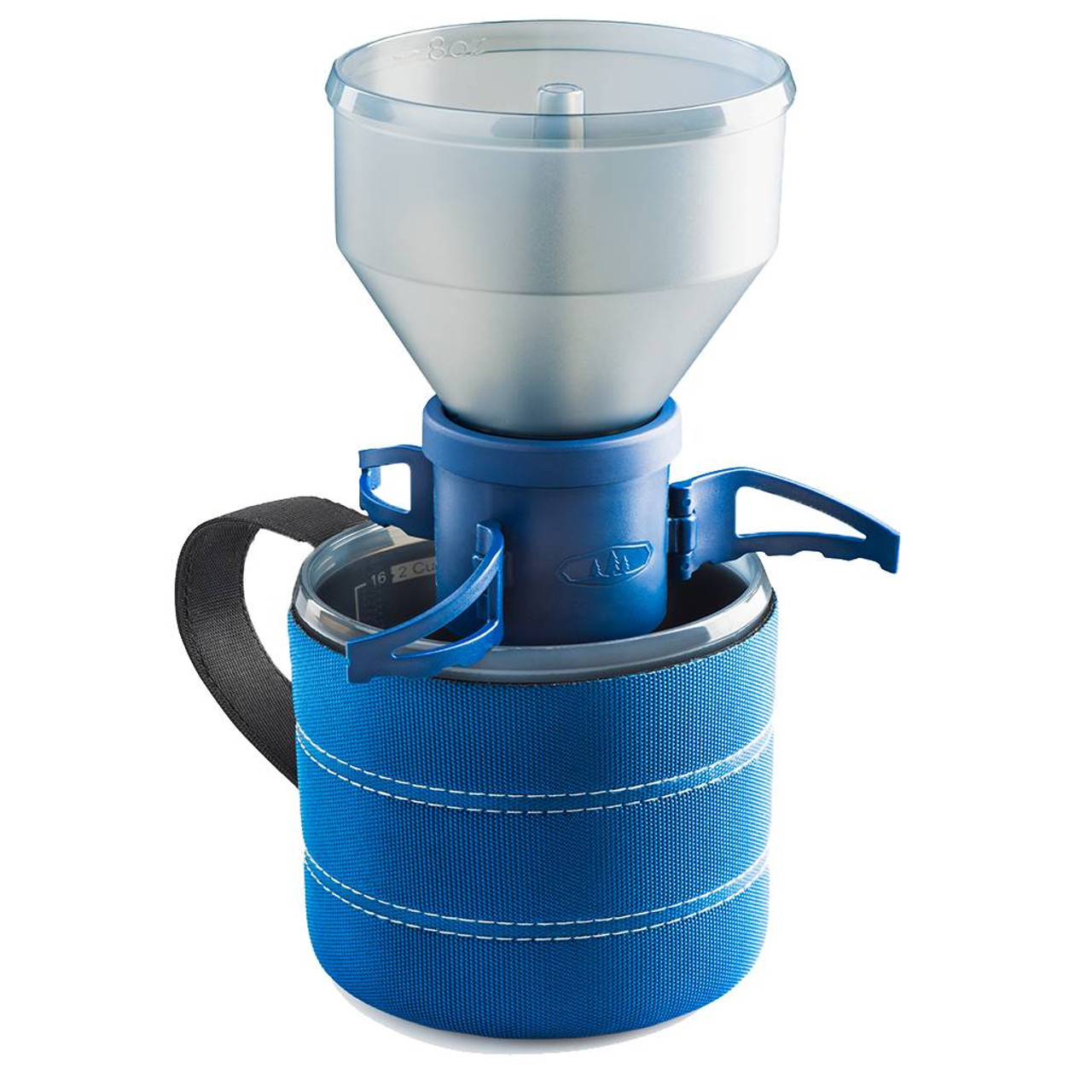Walks in Northamptonshire
The Northampton Knights
I can’t remember where I first read about the sculptures of knights scattered around Northampton, but it immediately made me search the internet to find out more. Turns out there are seven wooden sculptures, and as I love a quirky and/or historical walk, out came the maps and my walk planning software, and our Northampton Knights Walk was designed in a jiffy. The route visits all the sculptures, but also includes many other historical sites and some countryside. It made a wonderful combination!
The start and finish point of this circular walk is Northampton's Delapre Abbey. After a wet spell, the paths around there can be seriously muddy, so we waited for a drier period before attempting it. There are a number of options, too.
Our mapping software measures the Northampton's Knights walk as 7.5 miles long, but we linked it to our Northampton Heritage Trail and the combined route stretched to 11 miles.
If, on the other hand, you want a shorter stroll, you can split the Northampton Knights Walk into two smaller circular walks. One in the town centre meeting the knights, and the other along the river and around the lake.
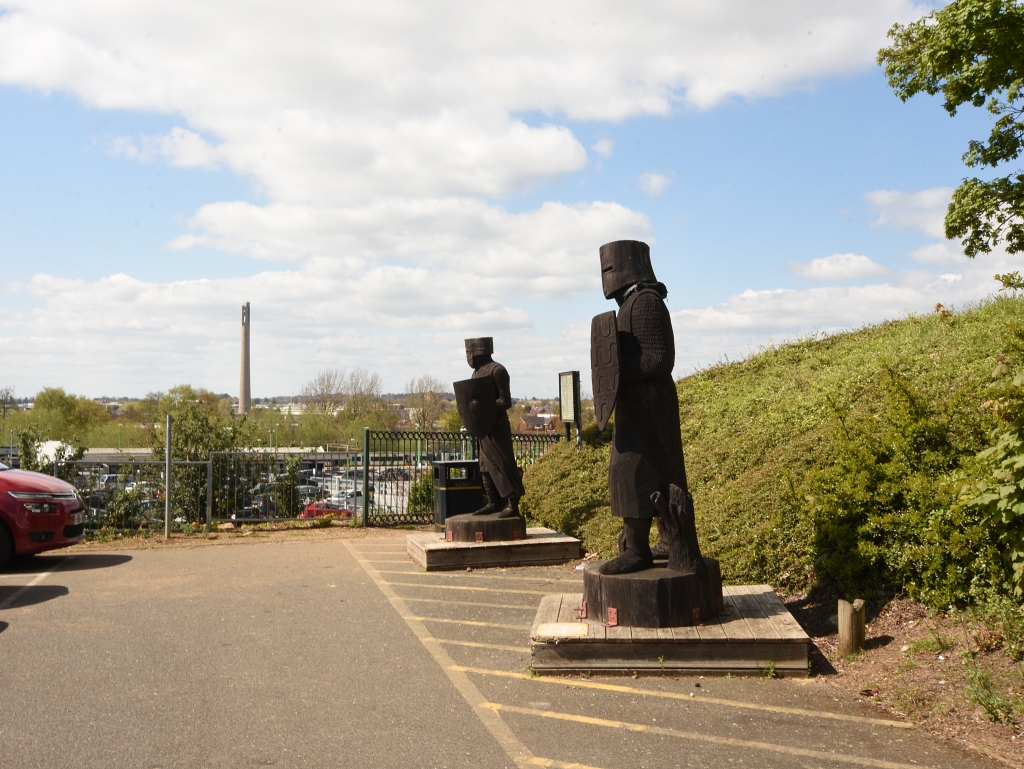 Knight Sculptures at Castle Mound © essentially-england.com
Knight Sculptures at Castle Mound © essentially-england.com
Northampton Knights Walk Map
Our Northampton Knights walk starts from the car park at Delapre Abbey. To find the car park use the postcode NN4 8AW and follow the signs. It would be wise to check the Delapre Abbey website before setting out as they do hold a lot of large events so it may get busy!
I’ve designed the walk to pass through the centre of town first and then out into the countryside. You can walk the other way round; it was just my preference to get the busier bit done first so that I could relax and enjoy the open landscape after.
I mapped the walk using komoot.com. If you’re a user, you’ll be able to follow the route on your phone or mobile device. If you use a GPS tracking device and need a gpx file, then click on “discover more info about this tour” to download the file.
Let’s go and meet the Northampton Knights…
From the car park, start walking towards the abbey buildings and you will meet the first two of the wonderful Northampton Knights.
This pair of wooden sculptures shows knights in the style of around 1460 guarding the abbey which lies behind them. To the left of the wooden gate, the first knight sits astride his war horse as it rears up. The knight on the right is dressed in the full-body, articulated plate armour used in battle.
It's easy to imagine that these knights might have fought in the first major battle of the War of the Roses! The Battle of Northampton in July 1460 resulted in the death of around 12,000 men and the capture of King Henry VI. He was held prisoner in Delapre Abbey.
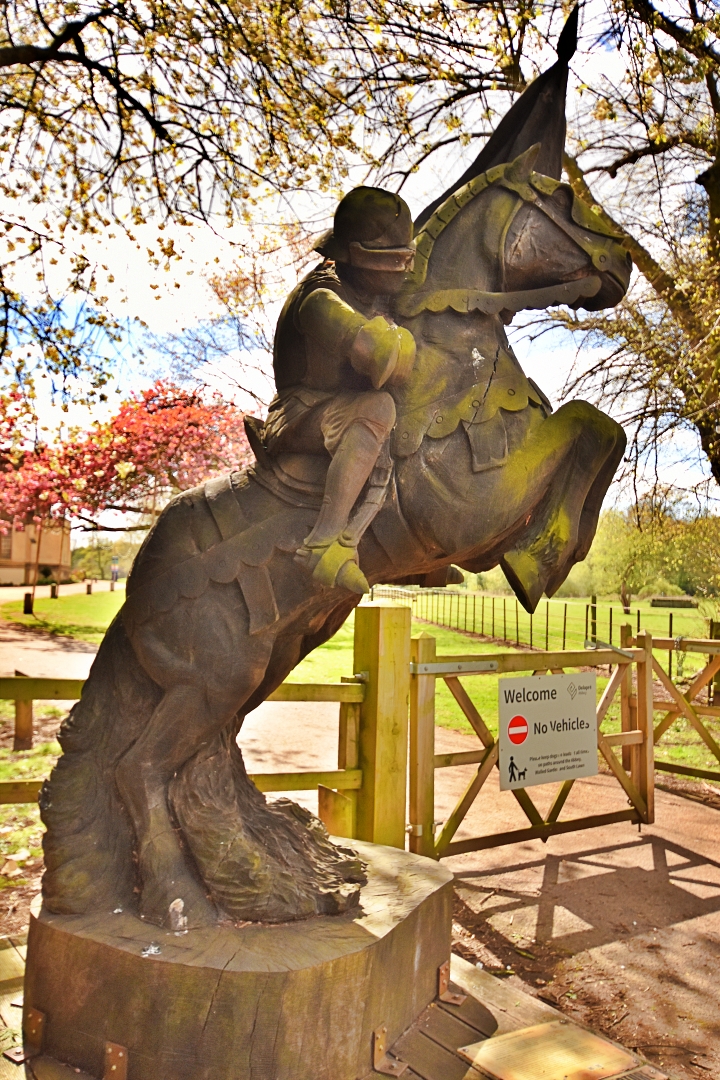 Northampton Knight on War Horse
Northampton Knight on War Horse © essentially-england.com
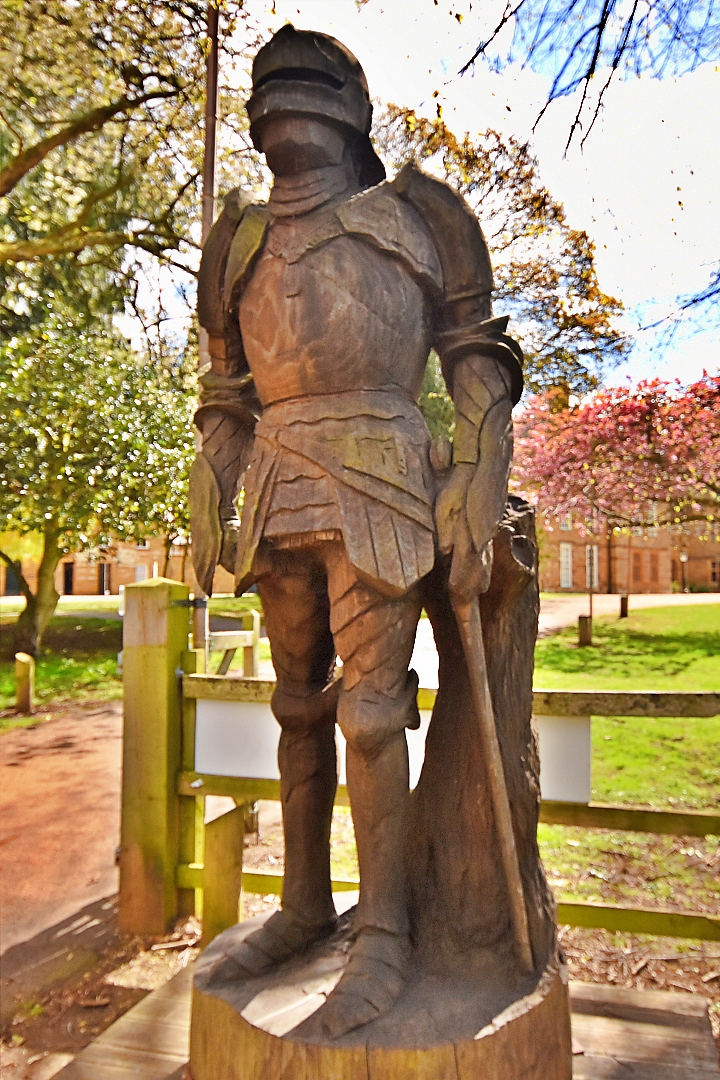 Northampton Knight at Delapre Abbey
Northampton Knight at Delapre Abbey © essentially-england.com
Walk through the wooden gate towards the abbey buildings.
Around 900 years ago, a group of Cluniac nuns arrived just outside the medieval walls of Northampton to establish a nunnery, the Abbey of St. Mary de la Pre. It was one of only two Cluniac nunneries in England and owed its adherence to the Abbey of Cluncy in France.
Although not a large abbey, it survived almost 400 years until King Henry VIII became head of the Church of England and closed all the monasteries, took their possessions, and sold their land. During its existence it played its part in several historic events including the Battle of Northampton and earlier, in 1291, as an overnight resting place for the cortege of Eleanor of Castile as King Edward I brought her body from Lincoln to London for burial.
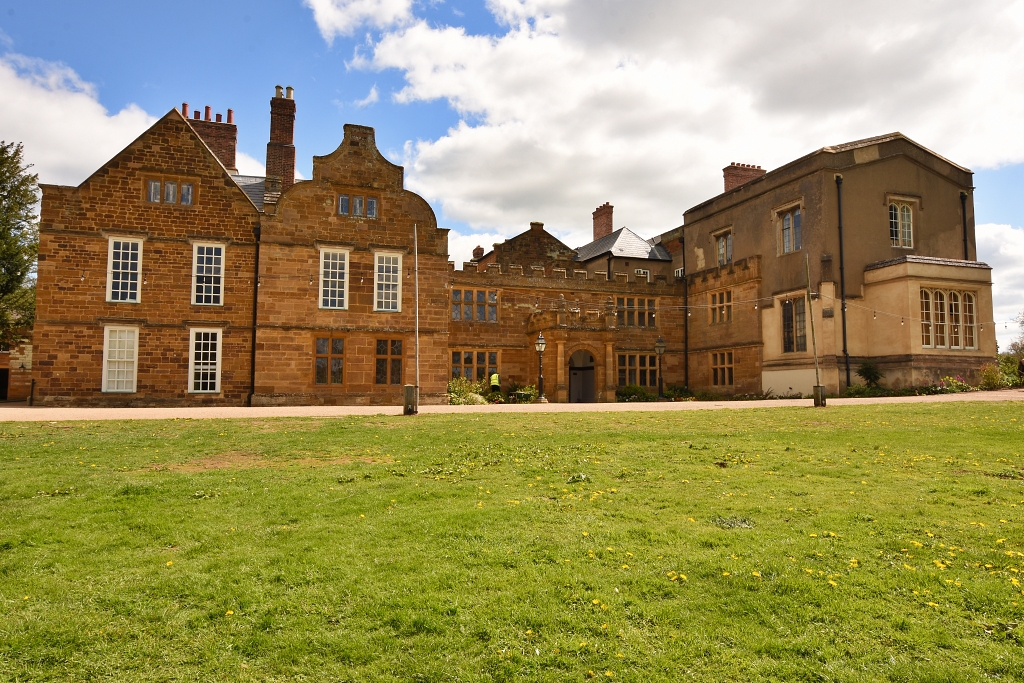 Delapre Abbey © essentially-england.com
Delapre Abbey © essentially-england.com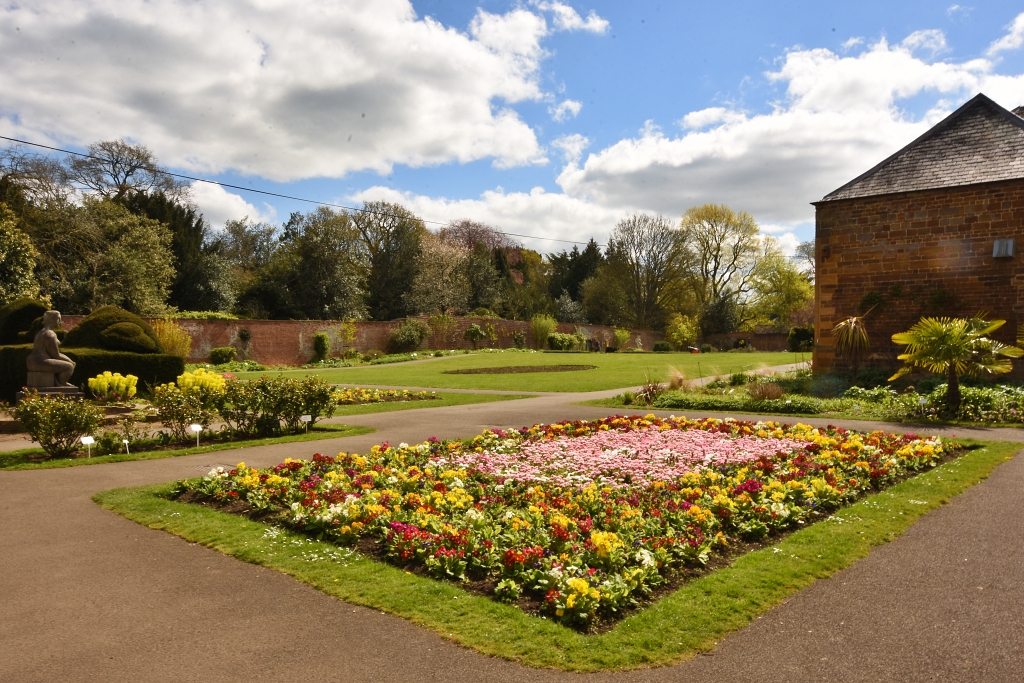 Delapre Abbey Gardens © essentially-england.com
Delapre Abbey Gardens © essentially-england.comAfter the dissolution, the abbey served as a family home until 1943, when the last owner died. The local council purchased the house and its land in 1946 and since then Delapre Abbey has been used for a variety of causes, but always been under threat of demolition. It has been extensively restored and the buildings and gardens are worth exploring. Click here for opening times and ticket information.
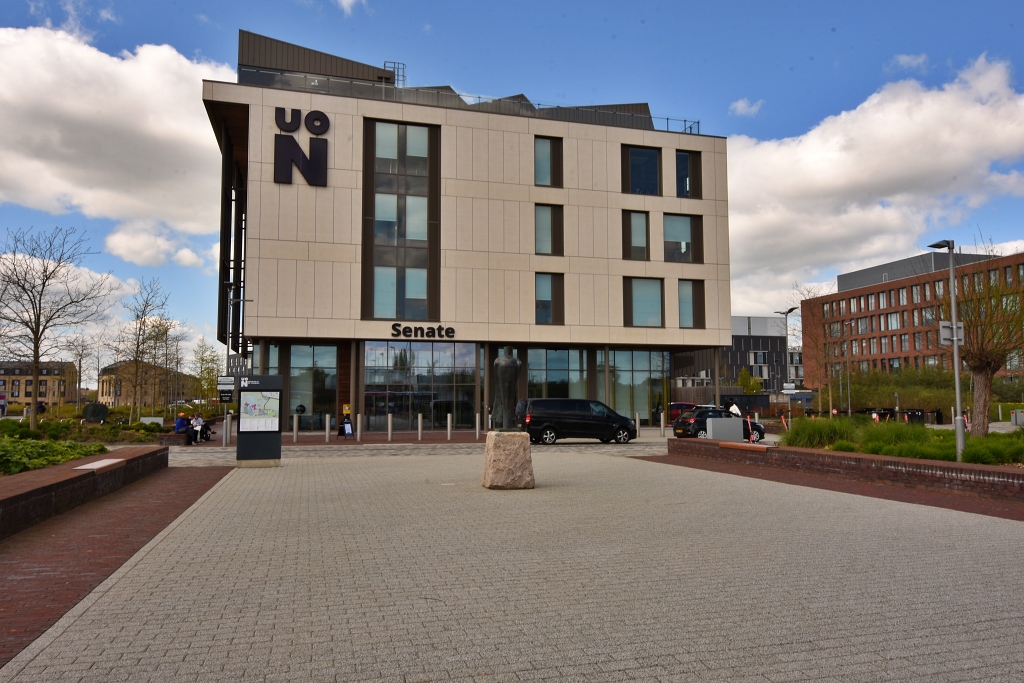 Univeristy of Northampton Riverside Campus
Univeristy of Northampton Riverside Campus © essentially-england.com
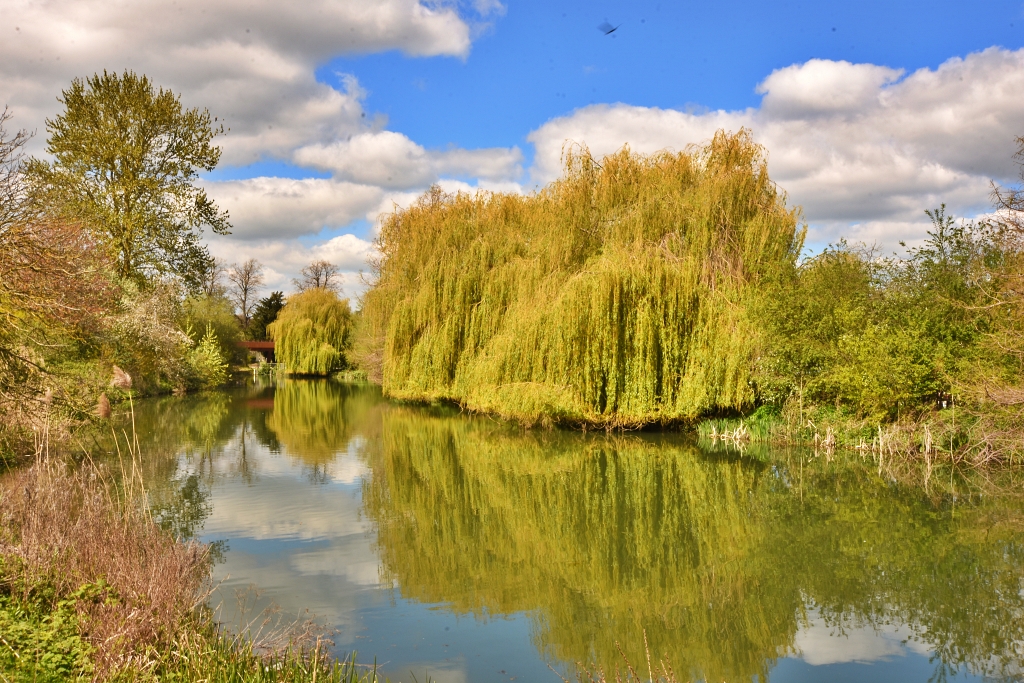 River Nene View
River Nene View © essentially-england.com
The route now follows the Mill Path through woodland and on to the University of Northampton Riverside Campus. As our walk heads towards the River Nene, you will pass several sculptures which are part of a local sculpture trail. Continue along the riverbank to cross the Nene on a red/rust coloured curved bridge.
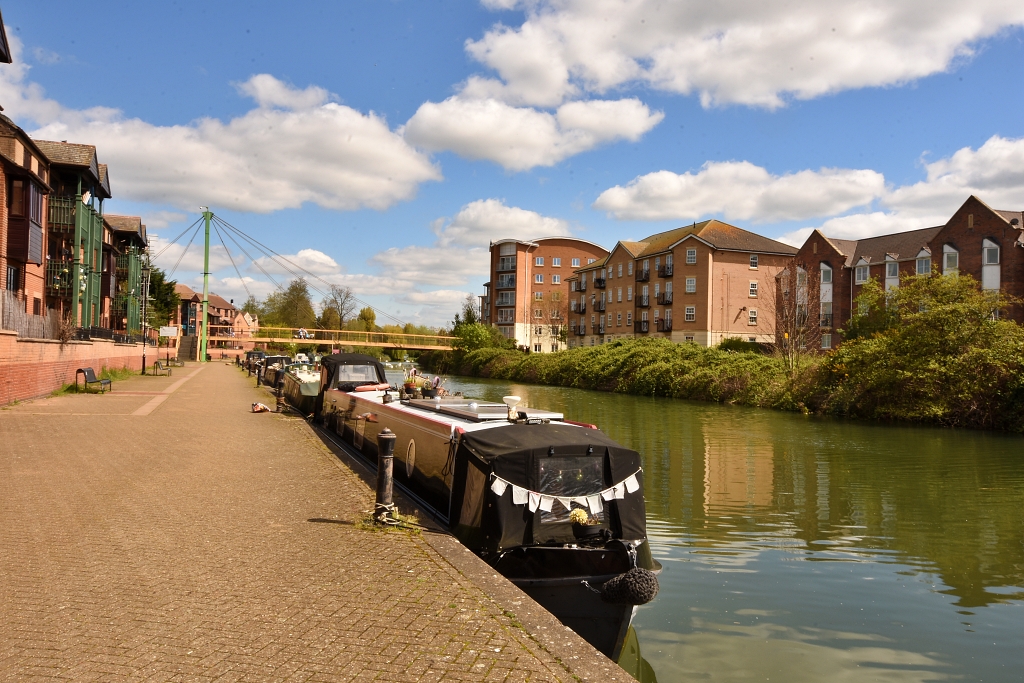 Looking Back at Canal Boats on the River Nene
Looking Back at Canal Boats on the River Nene © essentially-england.com
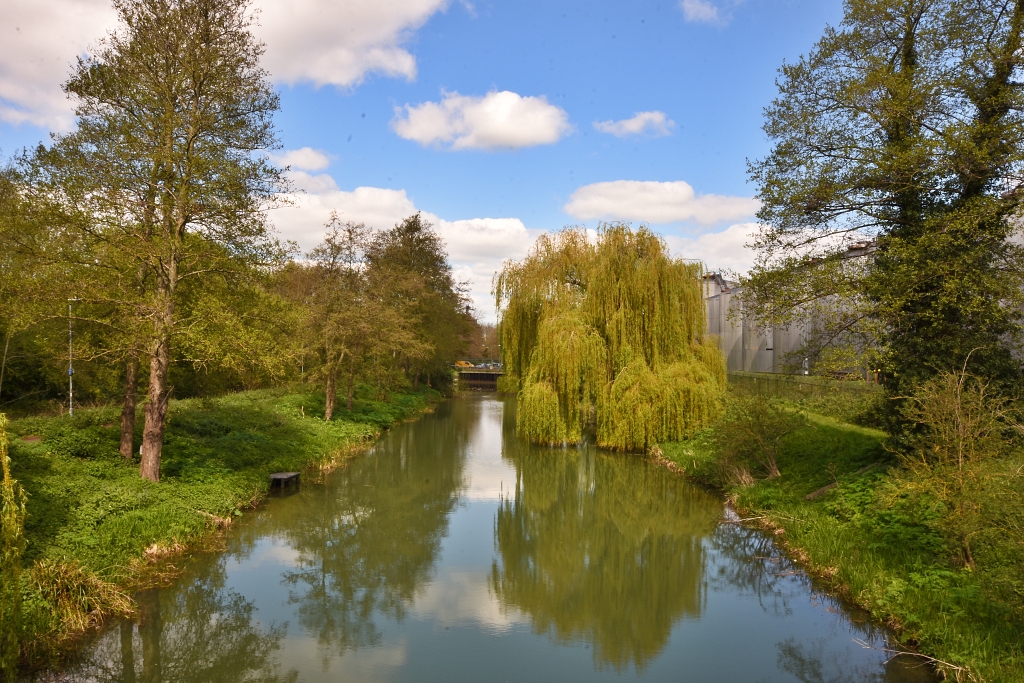 The River Nene Passing Behind the Brewery
The River Nene Passing Behind the Brewery © essentially-england.com
Continue along the bank of the River Nene between modern housing estates to Cotton End where we cross the road to rejoin the riverside. The path is narrower now and passes behind the Carlsberg Brewery to join St. Peter’s Way. Keep left at the roundabout and look for a footpath on the right-hand side of the road that goes between two branches of the River Nene. Follow the footpath through a narrow strip of parkland, under the railway lines to join West Bridge.
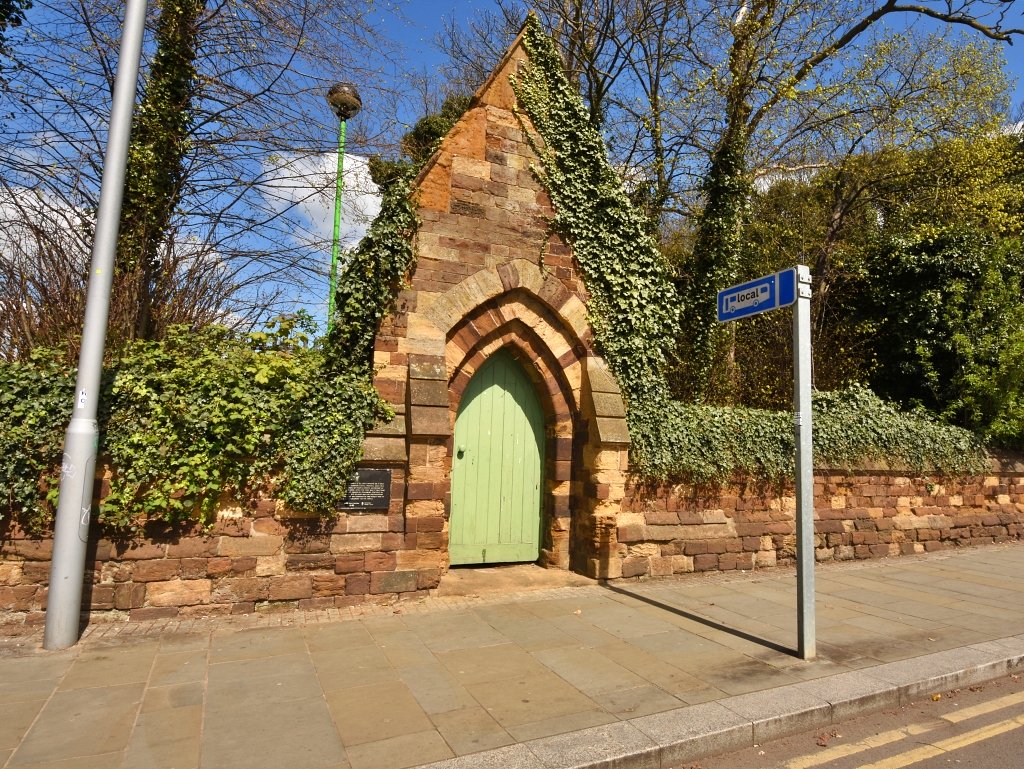 Northampton Castle Gate © essentially-england.com
Northampton Castle Gate © essentially-england.comCross the road and turn right towards the railway station. Shortly after the station you'll find this gate which is the last remaining stonework from Northampton Castle.
After the Civil War, King Charles II slighted Northampton Castle, ie. rendered it uninhabitable. The neglected ruins eventually made room for Northampton train station in 1879. As a monument to the once-impressive royal residence, one of the postern gates (side entrance) was dismantled and rebuilt here during the 1880’s.
It's here that our Northampton Heritage Trail and our Northampton Knights walk cross paths. If you're keen on seeing more historical sights, then take the Heritage Trail through the town centre.
If staying on the Knights walk, walk on past the postern gate, and up Black Lion Hill to the junction with Chalk Lane. Here, on the left under the trees, you find the next pair of wood sculptures. The first is the town crest, granted to Northampton by King Edward I. The tower is thought to be one of the medieval town gates and the two lions are taken from the King’s shield since Northampton was a royal borough. The inscription translates to “Peace is stronger than a fortress”.
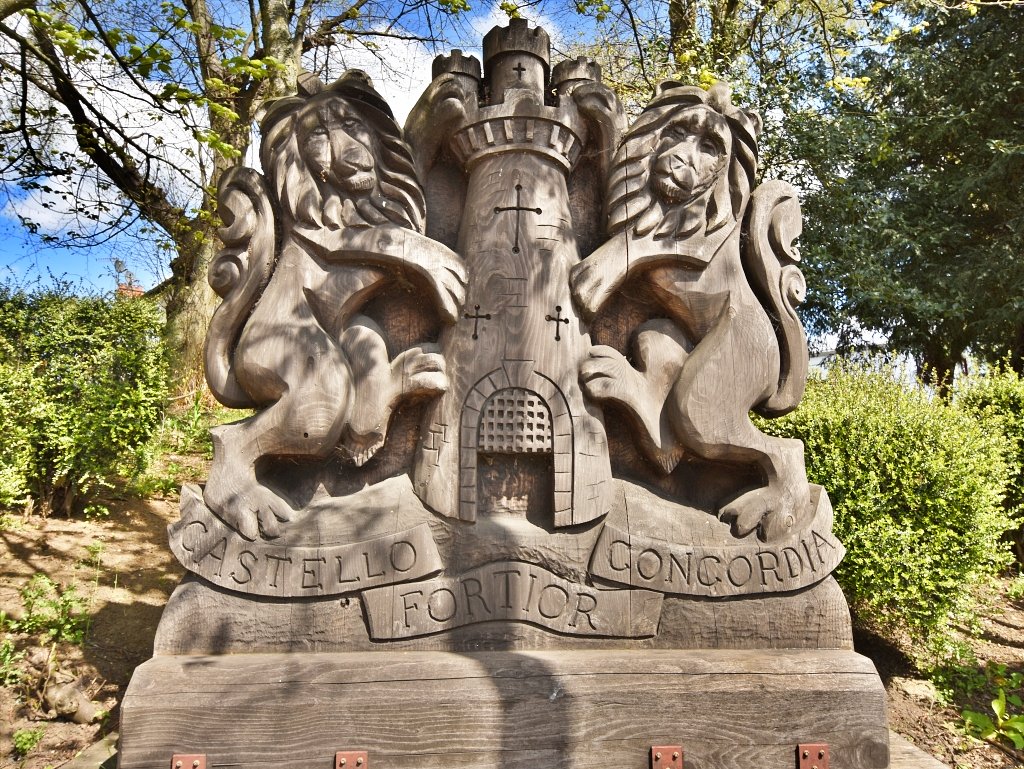 Carved Northampton Town Crest © essentially-england.com
Carved Northampton Town Crest © essentially-england.com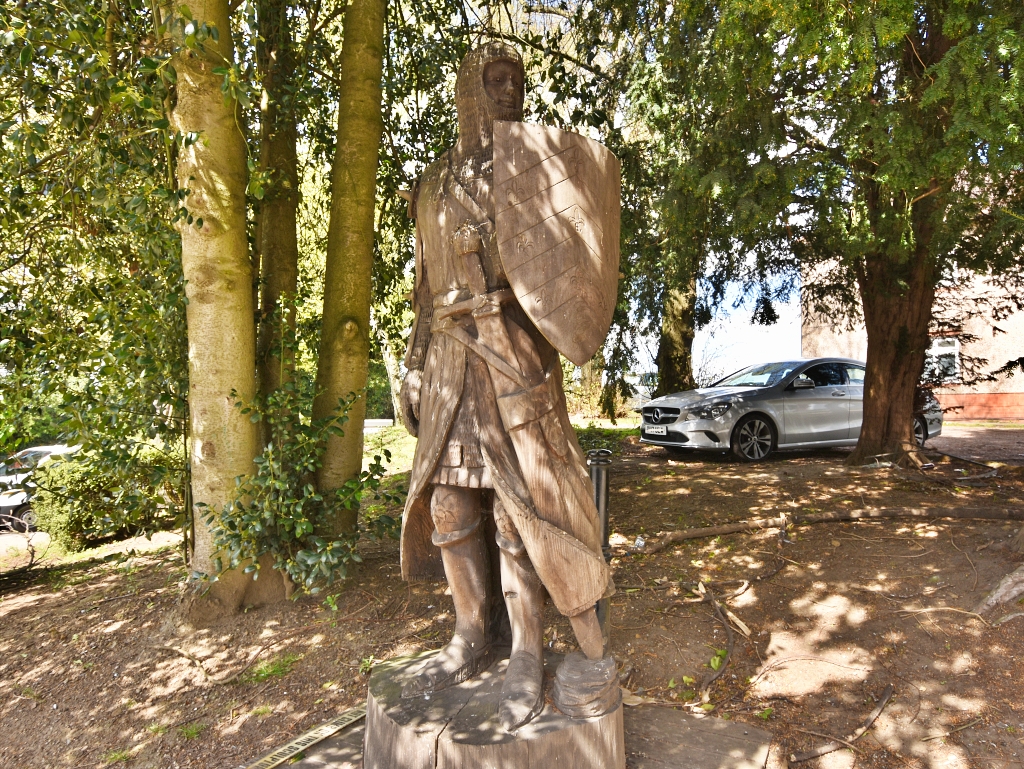 1330 Knight Sculpture © essentially-england.com
1330 Knight Sculpture © essentially-england.comThe knight is from around 1330 and wears a mail coat and hood with armoured plates or discs on the arms, elbows, and shoulders. Around this time, Northampton was at its most prosperous as it was a luxury royal residence situated along the road from London to York, and part of the circuit that the King and his court travelled. Many parliaments were held at Northampton Castle indicating the high standing of the town.
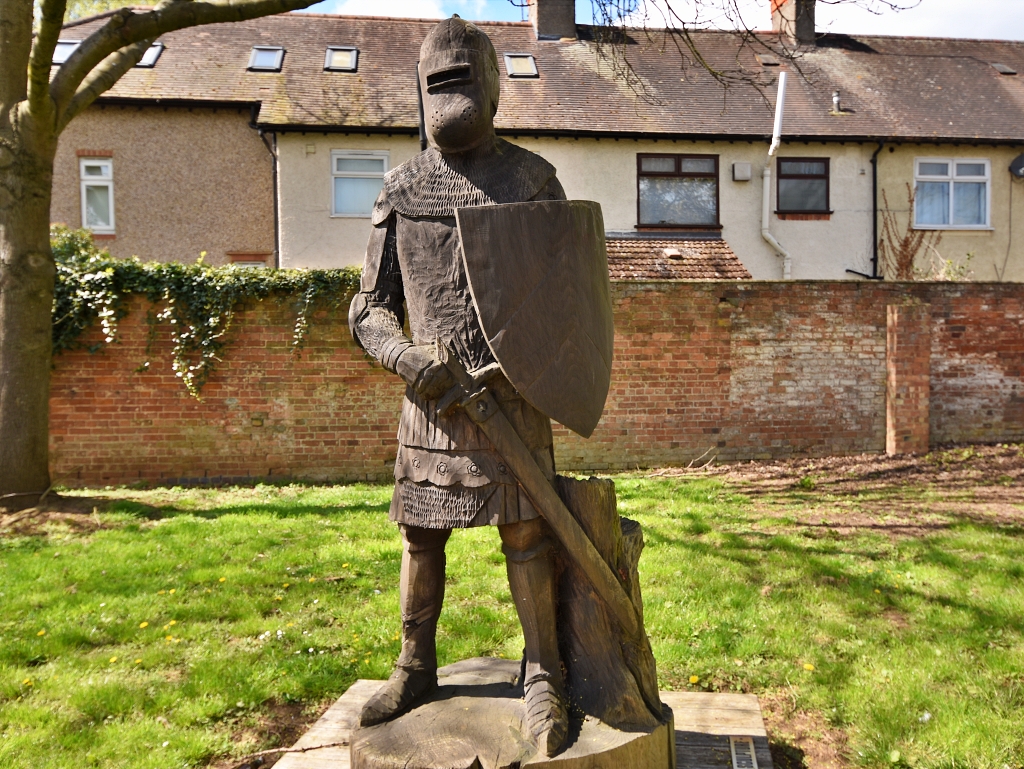 C1350 Wooden Knight Sculpture © essentially-england.com
C1350 Wooden Knight Sculpture © essentially-england.comTurn left up Chalk Lane.
Just before reaching Chalk Lane car park you'll find another wooden knight. This knight is from around 1350, just 20 years after our previous knight.
This was the time of the Black Death, when Northampton lost nearly half its population and maintaining an orderly society became a struggle. The knights of this time added new helmets and pieces of plate armour to their battle attire.
Now enter Chalk Lane car park and cross to the castle mound to see our last pair of knight sculptures. These knights are from around 1250 and would have lived in the reign of King Henry III. They may have fought in the first battle of the Barons War which started in Northampton in 1264 when the barons rebelled against Henry III’s poor rule.
The knights are wearing mail - made from thousands of small metal rings - under a cloth surcoat. It appears that around this time they started to experiment with using plate armour rather than mail as protection for the lower legs - as you can see from our two knights here. The helmet is plate metal with narrow slits to see through, and there seems to be a lack of plate metal guarding the arms.
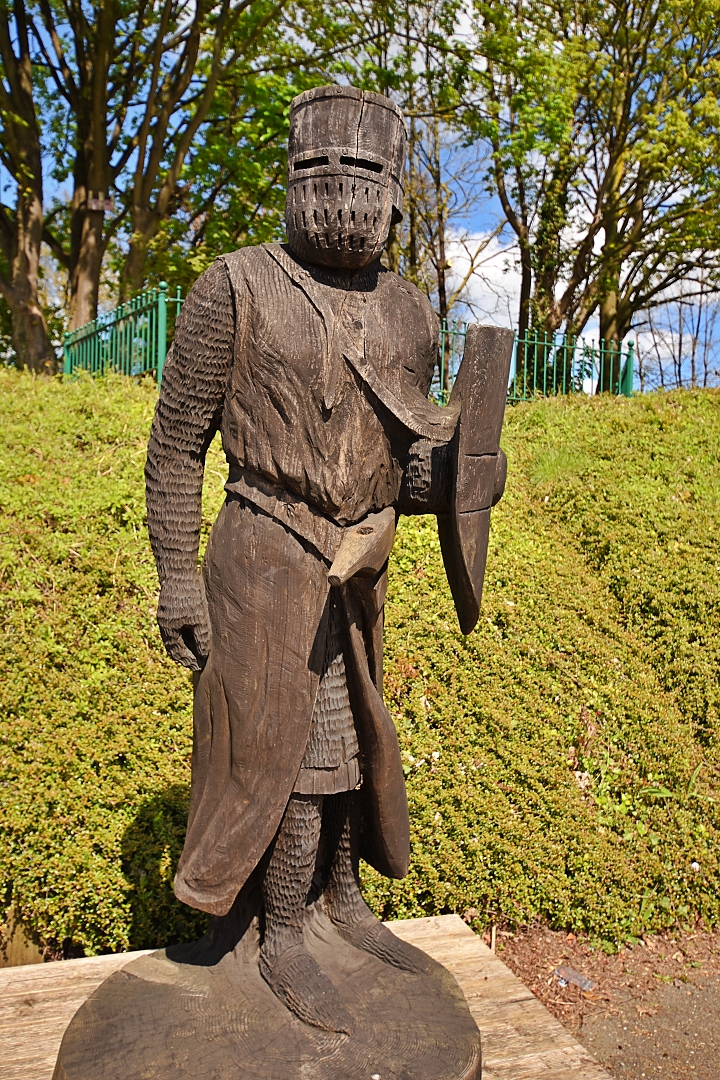 C1250 Northampton Knight
C1250 Northampton Knight © essentially-england.com
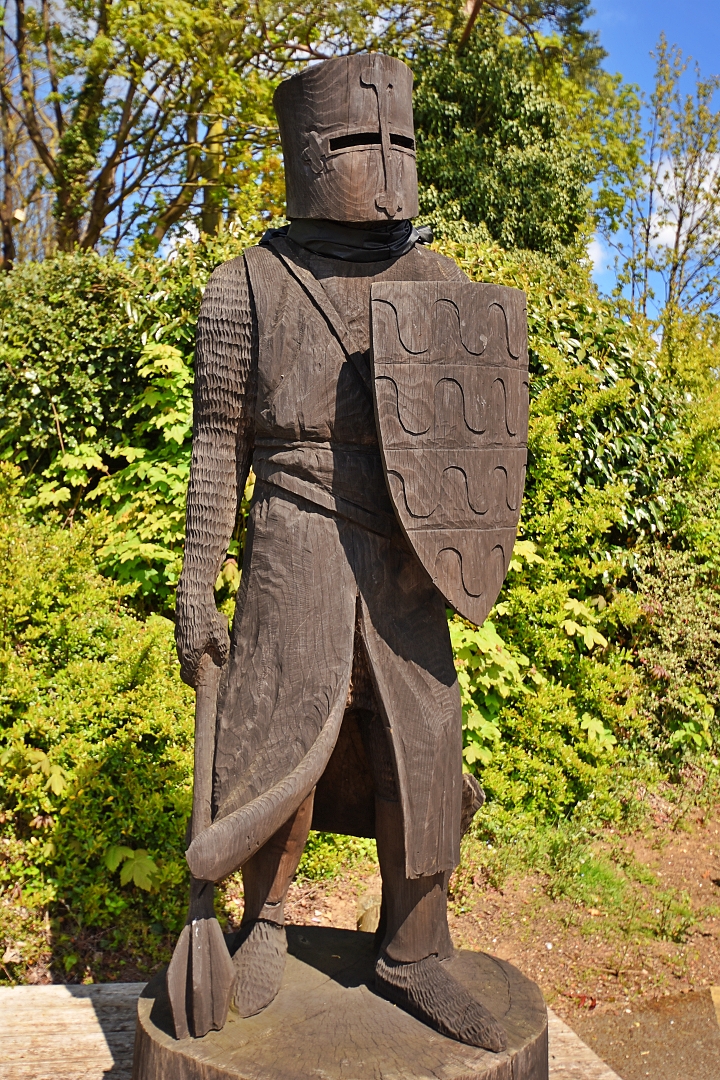 Northampton Knight at Castle Mound
Northampton Knight at Castle Mound © essentially-england.com
Now that we’ve met all the knights, we need to pass through the centre of town and head out into the countryside on our way back to Delapre Abbey.
Leave the carpark and cross the road to walk past the Castle Hill United Reform Church. Parts of this building date back to 1695 and use stone reclaimed from the castle ruins. Continue along St. Mary’s Street - which is believed to be the starting point of the great fire of Northampton in 1675 - and cross Horse Market into a small park. Keep straight ahead to join College Street Mews, then turn left and a quick right onto Swan Yard and up to The Drapery.
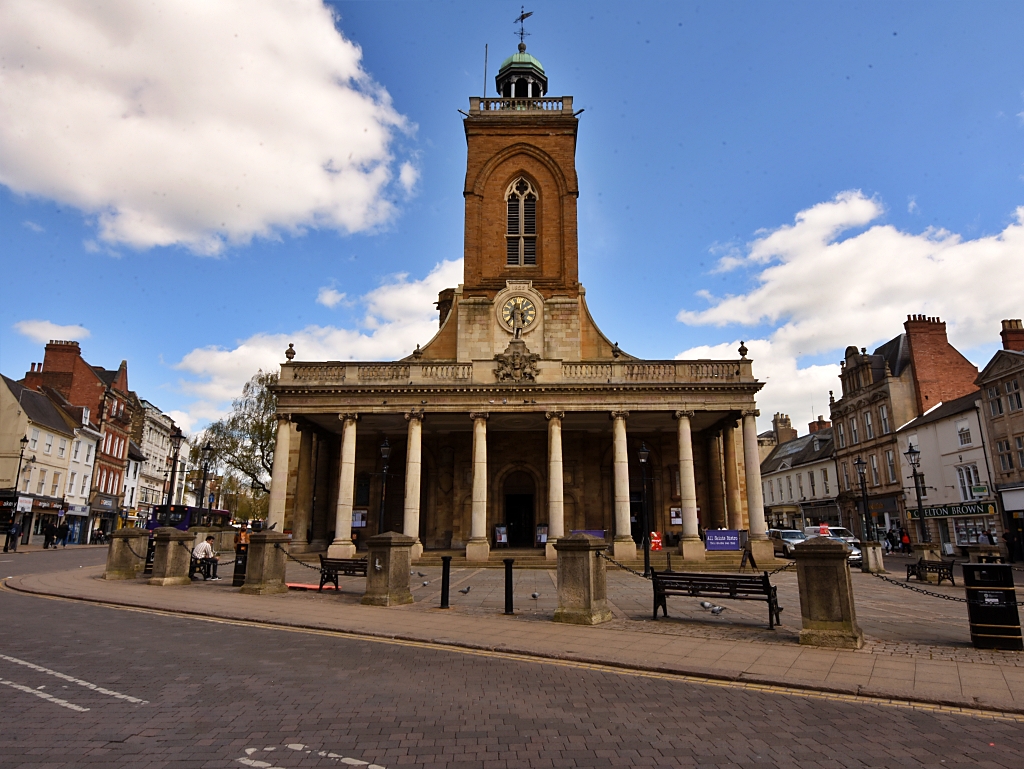 All Saints Church © essentially-england.com
All Saints Church © essentially-england.comDuring the 18th and 19th centuries, The Drapery was the heart of the cloth industry in Northampton. All that remains along this busy street now is some attractive listed buildings.
Turn right along The Drapery and walk past the Market Square. Northampton Market Square is one of the oldest and largest market squares in England and is surrounded by some lovely old buildings.
Turn left on to Mercer’s Row at the corner of All Saints Church. The church was rebuilt after the great fire. King Charles II contributed timber from the royal forests in Northamptonshire and reduced taxes to support the reconstruction. In 1712 a statue of the King was added to the front portico.
Walk along side the church to swing right past the Town and County War Memorial to then turn left on to Saint Giles Square where the impressive guildhall stands.
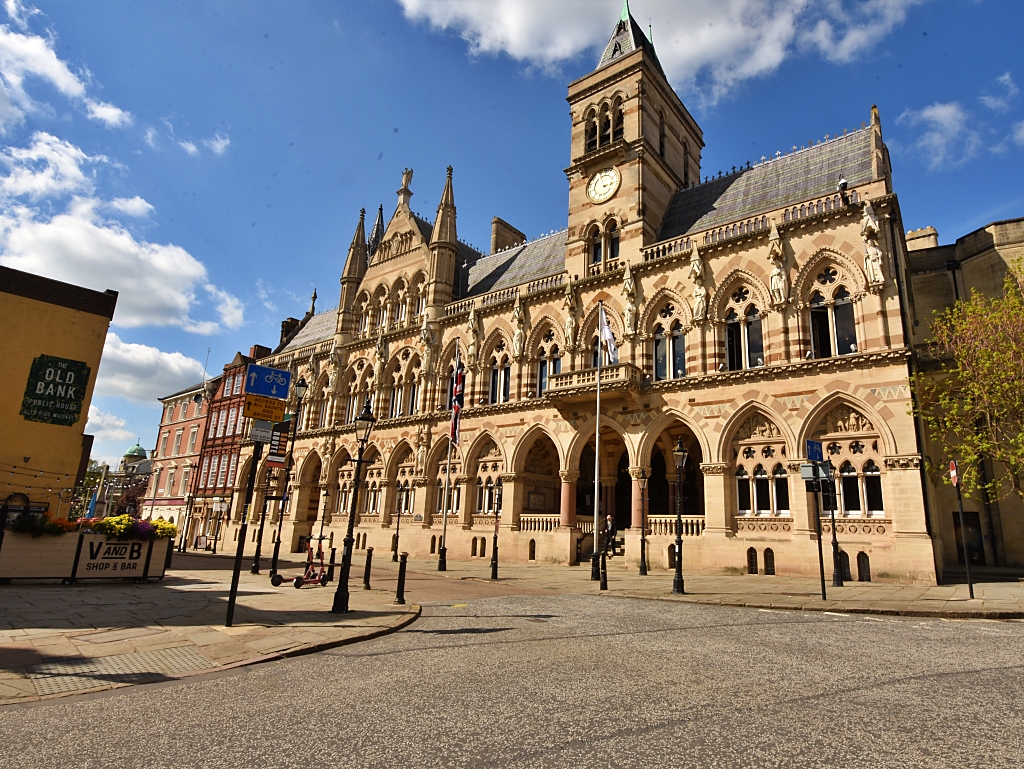 Northampton Guildhall © essentially-england.com
Northampton Guildhall © essentially-england.comOpened in 1864, the Northampton Guildhall is probably one of the most prominent buildings in Northampton. The fine exterior and interior decorations of this great gothic building record local historical events and influential people.
Turn right down Guildhall Road and enter Northampton’s Culture Quarter. On the left you pass the Royal Theatre which is part of the Royal and Derngate theatre and film complex. To your right is the Northampton Museum and Art Gallery. This is well worth a visit as there is an interesting collection on local history and a gallery showcasing the history of the shoe and Northampton’s famous shoemaking industry.
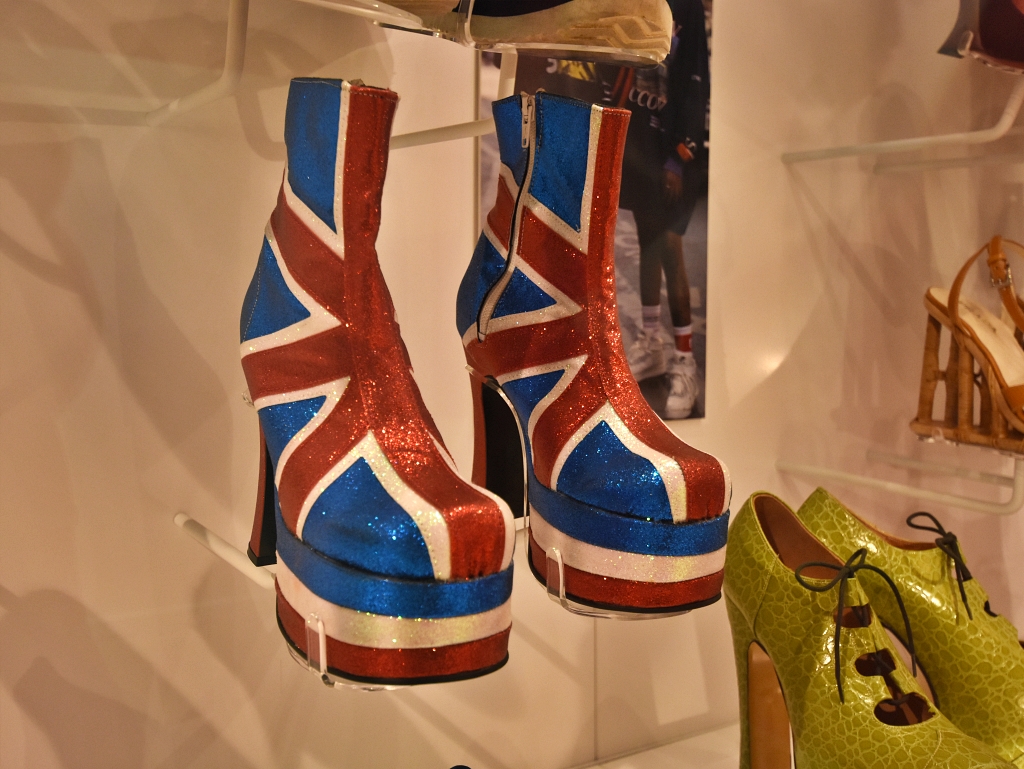 Northampton Museum Shoe Gallery © essentially-england.com
Northampton Museum Shoe Gallery © essentially-england.com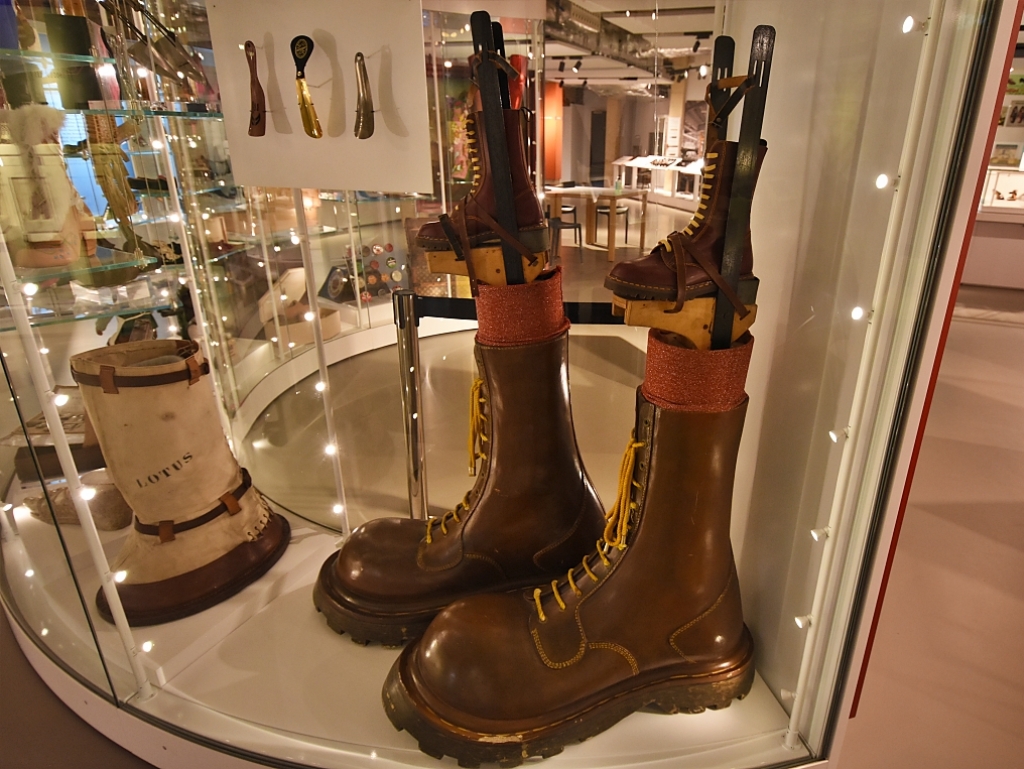 Elton John's Boots from Tommy © essentially-england.com
Elton John's Boots from Tommy © essentially-england.comShortly after the museum take the first left on to Angel Street. Walk past the main entrance to the Royal and Derngate theatre, and along a narrow passageway to Albion Place, where we turn left and walk up to Derngate.
Turn right on Derngate and descend to the major road junction. Just before the junction on the right-hand side of the road is 78 Dernsgate which is a Georgian terraced house that was modified by Scottish art nouveau/art deco architect Charles Rennie Mackintosh. Now a museum and café, it is his only major work outside of Scotland.
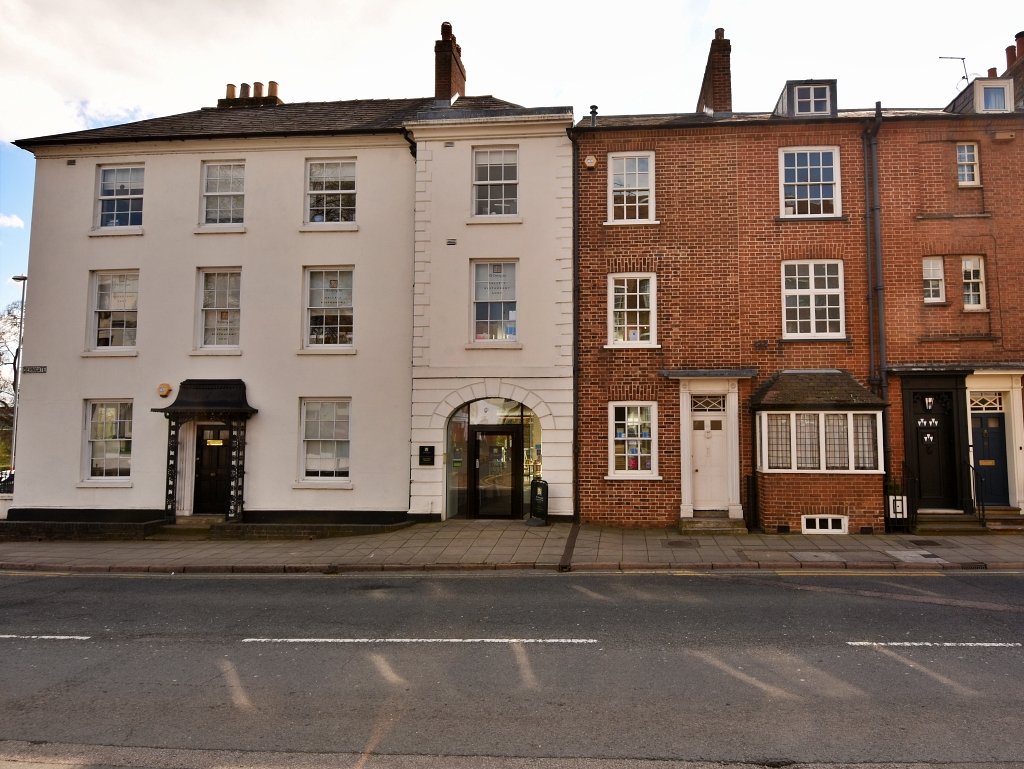 78 Derngate © essentially-england.com
78 Derngate © essentially-england.com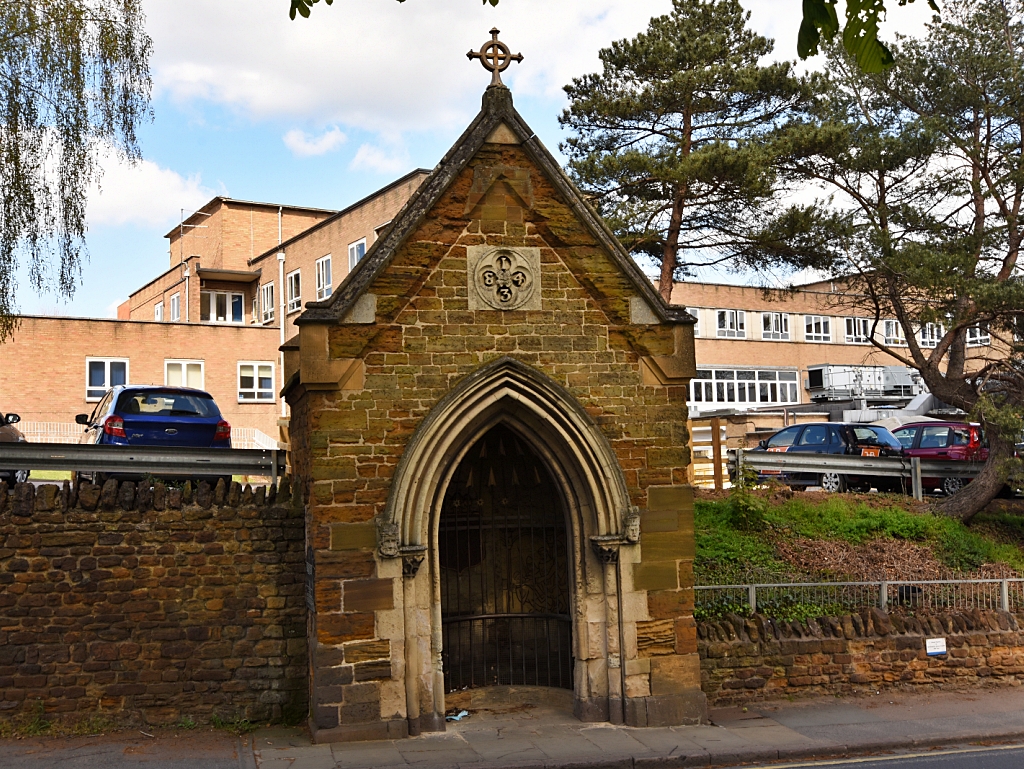 Becket's Well © essentially-england.com
Becket's Well © essentially-england.comNow cross the road and enter Becket’s Park, where you'll find the Silhouettes in the Park sculpture of John Clare, a poet, Charles Rennie Mackintosh, architect, and W.J. Bassett-Lowke, an engineer. Follow the path down to the corner of the park, cross the road that goes over the River Nene and join the multi-use path beside Midsummer Meadow car park. It’s at this point you could take a shortcut back to the start point!
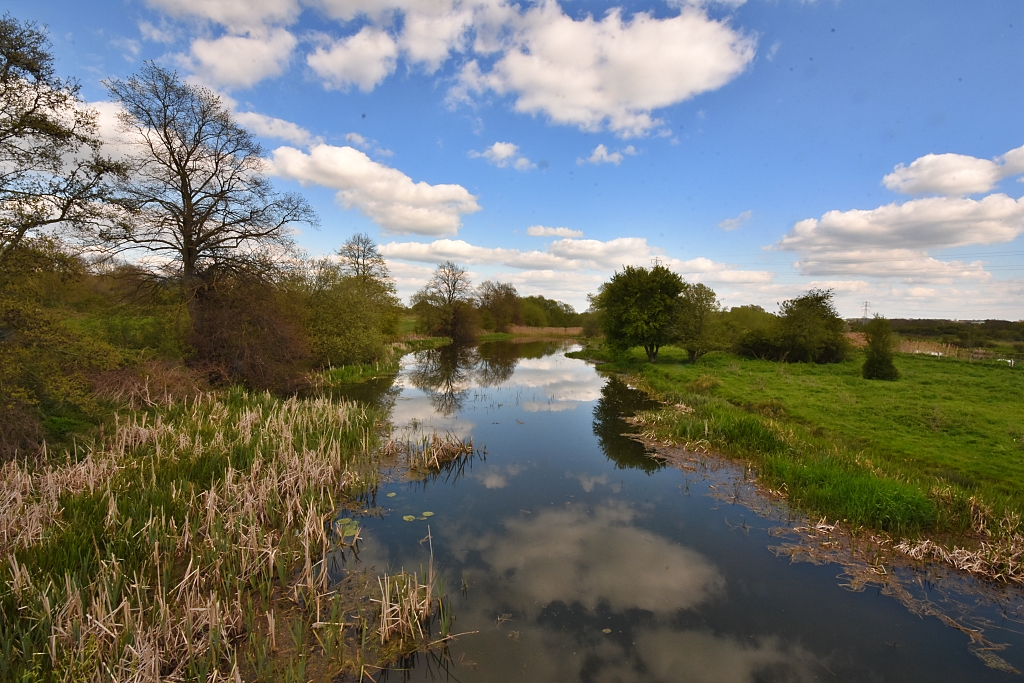 Reflections in the River Nene © essentially-england.com
Reflections in the River Nene © essentially-england.comThe well-surfaced path follows the bank of the River Nene and offers the chance for fine river views and wildlife spotting. Just after Northampton Skatepark, cross a small bridge to continue alongside the River Nene, under the A45 road bridge to the Nene Whitewater Centre.
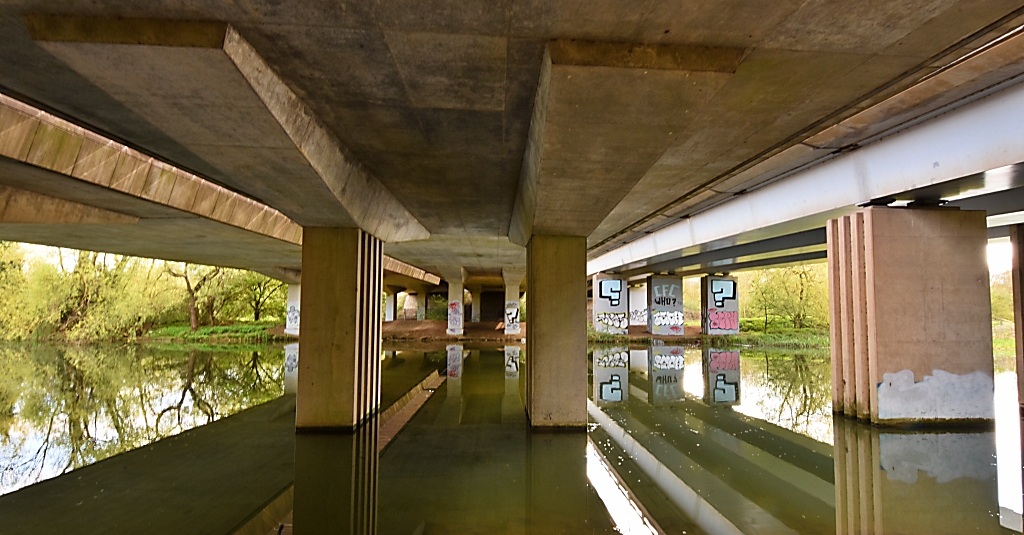 The A45 Road Bridge Crossing the River Nene © essentially-england.com
The A45 Road Bridge Crossing the River Nene © essentially-england.comTurn right over a bridge crossing the River Nene and follow the path to a smaller bridge crossing a branch of the river. Turn right after the bridge and follow the footpath along the opposite bank of the River Nene, back towards Northampton. Pass under the A45 road bridge again and start looking for a footpath on your left. Turn left, pass through a gate, and turn left again back towards the A45 road. Just before the road, turn right and shortly you get your first view of the beautiful Delapre Lake.
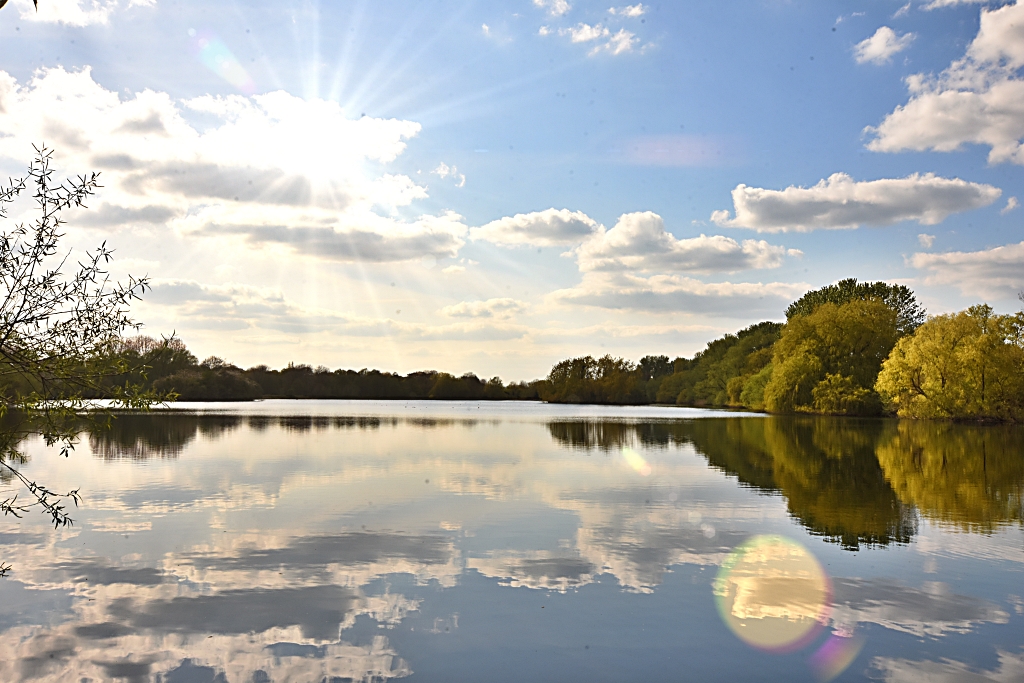 Reflections on Delapre Lake © essentially-england.com
Reflections on Delapre Lake © essentially-england.comThe footpath follows the edge of the lake, heading away from the noisy A45 road. After a while, the route departs from the lakeside and heads to the Delapre Golf Centre. The footpath joins Eagle Road and goes across the golf course, and Battle of Northampton battlefield, to the main carpark.
Shortly after entering the car park look for a footpath to the right that goes into the woods. This part of the walk is a little tricky to describe as there's a plethora of paths, but we managed to navigate our way through using both our GPS device and komoot.com on our phone.
You leave the woods as the footpath meets London Road. At this point, you'll find the last historical site, the Queen Eleanor Cross. This wonderful cross was built between 1291 and 1294 and is one of only three remaining crosses of the twelve erected by King Edward I at each overnight stop of his wife’s funeral cortege as it travelled from Lincoln to London.
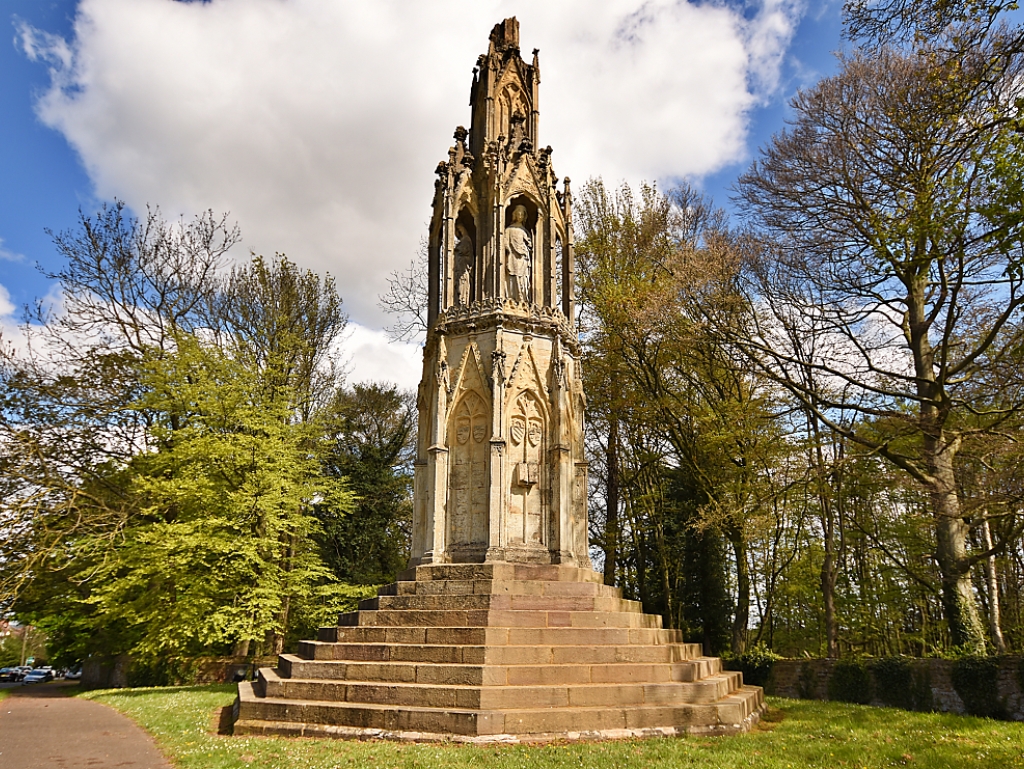 Queen Eleanor Cross in Northampton © essentially-england.com
Queen Eleanor Cross in Northampton © essentially-england.comTo complete the walk, re-enter the woods and follow the footpath that runs parallel with London Road. The path descends through the trees until it meets the main entrance to Delapre Abbey, where the route turns right to take you back to the car park.
We hope you enjoyed the varied interest around this lovely Northampton Knights walk. If you did, then you may be interested in some of our other walks that explore Northampton’s history and culture.
The Northampton Heritage Trail: - Discover the history of central Northampton and marvel at some of its oldest buildings.
The Northampton Shoe Quarter: - Northampton is famous for its shoemaking and inspired the film and stage musical “Kinky Boots”. We take a short walk around the shoe quarter to uncover what’s left and any unusual stories.
Abington Park stroll: - Apparently, Abington Park in Northampton is reported as one of the best parks in England. On this short walk we put our trainers on to see what’s what and report back our findings.
Hunsbury Park Iron Age Fort: - We step back in time and investigate an iron age fort where I’m sure we’ll find some strange things along the way. Well you know us by now!
Northamptonshire Holiday Cottages
Northamptonshire is a largely rural county in the centre of England, renowned for shoemaking, stunning countryside, and very pretty villages. It makes a great place for walking and cycling and is ideal for a relaxing holiday or short break.
Below, we've collected some holiday cottage ideas. Personally, I would love to stay in Stoke Bruerne, right next to the canal. Stoke Bruerne is a friendly, pretty village with a couple of pubs, an Indian restaurant, and easy walking from the door.
To browse holiday cottages in other parts of England click here, or you could use our Booking.com search box.
